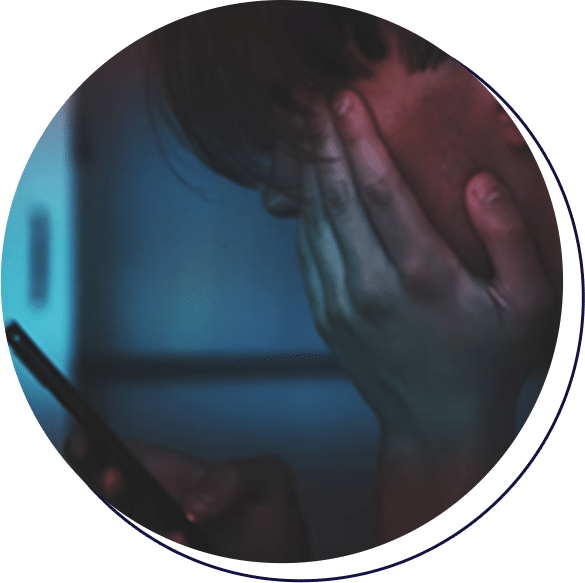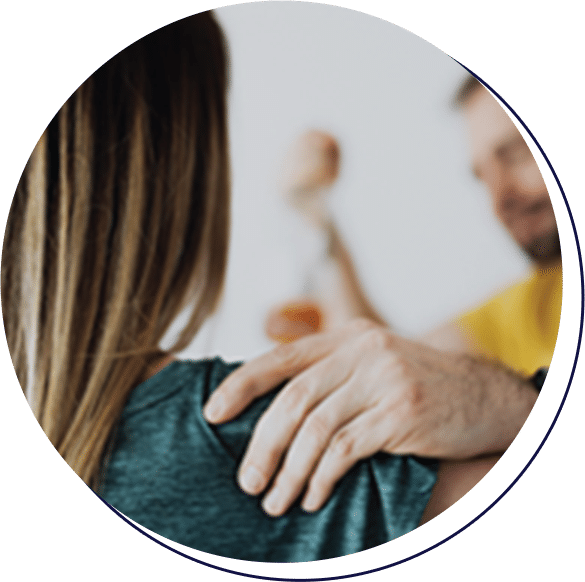Social Media and Sexual Violence
Sexual violence transcends culture, nation, race, and gender and is a concern for every person. It can devastate families and break communities apart. Not even the wealthy and famous are immune to harm from sexual predators. The rise of social media has made it even easier for sexual predators to connect with potential prey.
 Written and edited by our team of expert legal content writers and reviewed and approved by Attorney Matthew Bergman
Written and edited by our team of expert legal content writers and reviewed and approved by Attorney Matthew Bergman
- Content last updated on:
- June 12, 2025
Written and edited by our team of expert legal content writers and reviewed and approved by

- Content last updated on:
- June 12, 2025
Sexual violence is an all-encompassing term that refers to any type of forced or coerced sexual activity, including assault, abuse, online sexual harassment, and sex trafficking. It transcends culture, nation, race, and gender. It can devastate families and break communities apart.
Unfortunately, the rise of social media has made it even easier for sexual violence to happen and can even connect sexual predators with potential prey. This is referred to as “Technology-facilitated sexual violence” or “TFSV” where digital technologies are used to enable both virtual and face-to-face sexually based harms.
La Trobe University classifies four main types of technology-facilitated sexual violence.
- Online sexual harassment
- Gender- and sexuality-based harassment
- Cyberstalking
- Image-based sexual exploitation
According to the National Sexual Violence Resource Center, sexual violence occurs any time one person is manipulated or forced into sexual activity without their consent. In some cases, like those involving a child or when there is some type of power imbalance between the people involved, the victim can’t consent due to their position.
Lack of consent is the underlying factor in all forms of sexual violence, and it becomes easy to see how social media plays an increasing role in various categories of sexual violence.
Sexual Harassment – as defined by the U.S. Equal Employment Opportunity Commission – is a form of harassment characterized by “unwelcome sexual advances, requests for sexual favors, and other verbal or physical harassment of a sexual nature.”
While sexual harassment can occur at school, after-school activities, sports programs, or other places where young people aren’t directly supervised, it has become all-too common in online spaces, such as:
- Sending inappropriate and unwanted images, especially to minors
- Requesting inappropriate images, especially from minors
- Sending inappropriate emails, texts or social media messages
- Posting lewd or sexually indecent photos of the victim
- Use of obscene or vulgar language
- Discussions of sexual activity on social media
- Commenting on another person’s body or on their sexual matters in an online forum
Cyberstalking occurs when a perpetrator repeatedly makes unwanted online contact with a victim. It may involve persistent messaging, sending inappropriate or threatening images, and the creation of fake accounts to get around being “blocked.”
Cyberstalking can rob victims of their sense of safety and inflict lasting emotional damage. It also has the frightening potential to escalate to in-person conduct.
Sexual abuse, according to the American Psychological Association, is when a perpetrator takes advantage of the victim’s inability to give consent to force unwanted sexual activity. Online interactions can lead to in-person situations where this dangerous type of sexual abuse can take place.
Many sexual abuse victims know their perpetrators and often have been subject to grooming behavior, either in person or through a social media platform.
This relationship between victim and abuser often includes emotional manipulation, making the victim believe that they did consent, that they “wanted it,” or that they would hurt the abuser’s feelings or make them angry if they refused.
Immediate reactions to sexual abuse can be physical pain, shock, fear, and shame. Long-term, damaging psychological and emotional effects include:
- Depression and anxiety
- Post-traumatic stress disorder
- Difficulty forming intimate relationships
- Substance use disorders
- Self-harm
- Suicidal thoughts or attempts
The National Sexual Violence Resource Center defines Sexual Assault as any type of unwanted sexual contact, such as:
- Unwanted kissing of a sexual or non-sexual body part
- Unwanted touching of a sexual body part
- Attempted penetration or rape
- Rape, sodomy, or penetration
- Forcing another person to watch one masturbate
This is a physical form of sexual violence and can happen either between people who know each other or by a perpetrator who is a stranger to the victim. Sometimes, sexual assault is an escalation of sexual harassment that begins online.
Sexual assault can happen to anyone, man or woman. Without a victim’s consent, all sexual acts are considered sexual assault. Regardless of what the victim was wearing, their gender, or even whether they were drinking or using drugs, sexual contact without consent is assault.
That includes the following circumstances:
- Online sexual harassment
- Child sexual assault and abuse
- Rape or forced penetration
- Unwanted sexual touching or contact
- Sexual harassment or unwanted sexual comments
- Sexual exploitation
- Flashing or displaying genitals without consent
- “Revenge porn,” or sharing intimate images without permission
- Watching an intimate act without permission
If you were a victim of harassment online, report the incident to the relevant platform or moderator and document everything that happened, including preserving any messages.
Anyone can be a victim of sexual violence, and it’s important to understand the forms sexual violence can take, what to do after you’ve been harmed, and your options for justice. Above all, a victim of sexual violence is still a victim, no matter who they are or the circumstances.
If you or someone you love has been a victim of online sexual violence, you have hope and legal recourse. An attorney specializing in pursuing claims against online platforms and social media companies can help. The Social Media Victims Law Center works to hold social media companies legally accountable for the harm they inflict on vulnerable users. For more information and resources to help with online sexual violence, reach out to our team today for a free confidential case evaluation.
Perhaps, by raising awareness and shining a light on these offenses, such as through the #MeToo movement, we can change conditions that lead to sexual violence.
What is sexual violence?
Sexual violence is an overarching term that refers to any type of forced or coerced sexual activity, including assault, abuse, online sexual harassment, and sex trafficking.
Lack of consent is the underlying factor in all forms of sexual violence, including:
- Online sexual harassment
- Child sexual assault and abuse
- Rape or forced penetration
- Unwanted sexual touching or contact
- Sexual harassment or unwanted sexual comments
- Sexual exploitation
- Flashing or displaying genitals without consent
- “Revenge porn,” or sharing intimate images without permission
- Watching an intimate act without permission
Several forms of sexual violence can occur or be facilitated online. According to research done by La Trobe University, “Technology-facilitated sexual violence (TFSV) refers to a range of behaviors where digital technologies are used to facilitate both virtual and face-to-face sexually-based harms.”
According to this research, there are four main types of TFSV:
- Online sexual harassment
- Gender- and sexuality-based harassment
- Cyberstalking
- Image-based sexual exploitation
The National Sexual Violence Resource Center states that sexual violence occurs any time one person is manipulated or forced into sexual activity without their consent. In some cases, such as those involving a child or some type of power imbalance between the people involved, the victim can’t consent due to their position.
Other times that a victim cannot consent would be:
- The victim is under the influence of alcohol or drugs.
- The victim is physically forced.
- The victim is coerced with threats against their livelihood or family.
- The victim consents out of fear.
- The victim is infirm or otherwise disabled to the point of being unable to legally consent.
- The victim is underage.
Anyone can be a victim of sexual violence, and it’s important to understand the forms sexual violence can take, what to do after you’ve been harmed, and your options for justice. Above all, a victim of sexual violence is still a victim, no matter who they are or the circumstances.
Types of Sexual Violence
Sexual violence is typically classified into different categories. In cases where criminal charges are filed, the type of sexual violence the offender is charged with will largely determine their penalty.
In civil matters, the type of sexual violence is also important, as many cases pursue claims due to the victim’s trauma, physical harm, and diminished quality of life.
Sexual Harassment
The U.S. Equal Employment Opportunity Commission (EEOC) defines sexual harassment as a form of harassment characterized by “unwelcome sexual advances, requests for sexual favors, and other verbal or physical harassment of a sexual nature.”
Sexual harassment is common in online spaces, and can also occur at school, after-school activities, sports programs, or other places where young people may be outside of direct supervision. Sexual harassment may cross the line into physical contact or assault.
Some common forms of sexual harassment online include:
- Sending unwanted, inappropriate images, especially to minors
- Requesting inappropriate images, especially from minors
- Sending inappropriate emails, texts or messages on social media
- Posting lewd or sexually indecent photos of the victim
- Use of obscene or vulgar language
- Discussions of sexual activity on social media
- Commenting on another person’s body or speculating on sexual matters pertaining to them in an online forum
Cyberstalking
Cyberstalking occurs when a perpetrator repeatedly makes unwanted contact with a victim online. It may involve persistent messaging, the sending of inappropriate or threatening images, and the creation of fake accounts to circumvent “blocking.”
Cyberstalking can itself be a form of abuse, but it also has the potential to escalate to in-person conduct. Even if no in-person conduct occurs, cyberstalking can rob victims of their sense of safety and inflict lasting emotional damage. Cyberstalking, particularly of minors, is potentially dangerous and should be taken seriously.
Sexual Abuse
Sexual abuse, according to the American Psychological Association, is forced unwanted sexual activity in which the perpetrator takes advantage of the victim’s inability to give consent. Online interactions can lead to in-person situations in which this type of sexual abuse can occur.
The term is commonly used to refer to circumstances involving a child victim but can include any incident in which a power imbalance exists, such that the victim cannot consent.
Many sexual abuse victims know their perpetrators and often have been subject to grooming behavior, whether this happens in person or through a social media platform.
Often, the relationship between victim and abuser includes emotional manipulation. The victim may believe that they did consent, that they “wanted it,” or that they would hurt the abuser’s feelings or make them angry if they refused.
Immediate reactions to sexual abuse can be shock, fear, physical pain, and shame. Sexual abuse doesn’t just hurt victims at the moment. Long-term, damaging psychological and emotional effects include:
- Depression and anxiety
- Post-traumatic stress disorder
- Difficulty forming intimate relationships
- Substance use disorders
- Self-harm
- Suicidal ideation, or suicide attempts
The power imbalance in cases of sexual abuse makes it difficult for victims to come forward to disclose the abuse and seek justice against the perpetrator. Victims may fear repercussions against their family or livelihood or fear they will no longer be welcome in their community.
Other times, victims think they will not be believed because of the reputation or the powerful position of the abuser. This is why it’s important for parents to know the signs of sexual abuse in their children.
Sexual Assault
The National Sexual Violence Resource Center defines sexual assault as any type of unwanted sexual contact.
This can take many forms, including:
- Unwanted kissing of a sexual or non-sexual body part
- Unwanted touching of a sexual body part
- Attempted penetration or rape
- Rape, sodomy, or penetration
- Forcing another person to watch one masturbate
Assault is a physical form of sexual violence and can happen between people who know one another or by a perpetrator who is a stranger to the victim. Sometimes, sexual assault is an escalation of sexual harassment that begins online.
Sexual assault can happen to anyone, man or woman. If the victim did not give consent, the subsequent sexual acts are considered sexual assault. Regardless of the victim’s circumstance, such as what they were wearing, their gender, or whether they were drinking or using drugs, sexual contact without consent is assault.
The immediate and long-term effects of sexual assault are the same as those of sexual abuse, including pain, shame, and emotional trauma.

What do I do if I’ve been a victim of sexual violence?
If the sexual violence involved physical contact, visit your local hospital for an exam to treat your injuries and gather physical evidence in case you wish to press charges.
If you disclose to the medical team that you were a sexual assault victim, you’ll be afforded protection and asked if you would like to speak to an on-site counselor.
If you were a victim of harassment online, report the incident to the relevant platform or moderator and document everything that happened, including preserving any messages.
More Information and Legal Resources
If you or someone you love has been a victim of online sexual violence, you have hope and legal recourse. An attorney specializing in pursuing claims against online platforms and social media companies can help. For more information and resources to help with online sexual violence, visit the Social Media Victims Law Center.
Frequently Asked Questions
For individuals and children who have been
We only handle cases on a contingent fee basis. This means that we are paid a portion of any recovery obtained in the case and you do not owe us any attorneys’ fees if the lawsuit does not result in a recovery.
Every case is unique. Our attorneys will work with your family to evaluate your potential case and help you evaluate whether filing a lawsuit or other legal proceeding is in your family’s best interest. Generally speaking, the types of cases we handle involve serious mental health effects, including attempted or completed suicide, eating disorders, inpatient mental health treatment, or sexual trafficking/exploitation that was caused by or contributed to through addictive or problematic social media use by teens and young adults.
We are a law firm based near Seattle, WA comprised of lawyers who have spent their entire careers representing victims who have been harmed by dangerous products. We are also parents. Shocked and troubled by the recent revelations about the harm caused to teens and young adults by social media platforms, which powerful technology companies have designed to be highly addictive, Social Media Victims Law Center was launched specifically to help families and children who have suffered serious mental harm or exploitation through social media use to obtain justice.
Contact Us Today
Related Pages
Client Testimonials
Explore Popular Topics

Addiction

Suicide

Eating Disorders

Anxiety

Bullying

Sexual Abuse

Body Image

